The 14th and last of the series of posts of selected black and white pictures I made in 1980 with the comments I posted more recently daily on Facebook. Larger versions of the pictures are now available on Flickr.
Apologies for some earlier posts in this series that were titled as London 1990 – and I hope I have now corrected all these. It will be a little while before I have caught up with my work from 1990! This is the final post of pictures that I made in London in 1980.
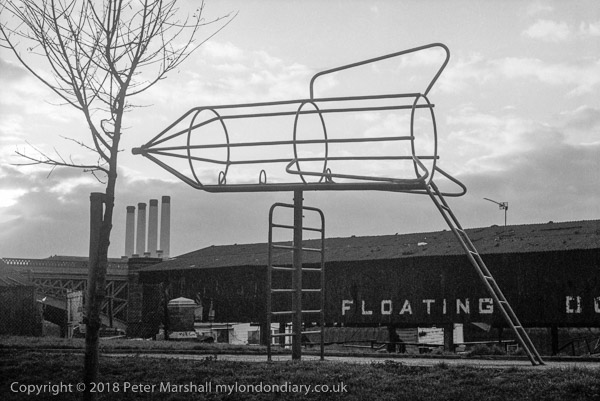
26r-24: spaceship, playground power station, bridge,
http://londonphotographs.co.uk/london/1980/26r-24.htm
Behind the spaceship in a childrens’ playground are the four in-line chimneys of Fulham Power Station, decommissioned in 1978 and one of the first power stations that the CEGB was made redundant and sold for redevelopment. The demolition in the early 1980s became controversial over the safety of the removal of around 1,000 tons of asbestos by the new owners. Because of this the government announced that the CEGB would strip asbestos before selling power stations in future.
The Regent on the River apartments that replaced the power station in the 1980s supposedly were designed to reflect the architecture of the power station.
I carefully framed the word ‘FLOATING’ underneath the spaceship, thinking of it floating in space. I think this was a floating dry dock. At left you can see a small part of the Battersea Rail Bridge, now used by London Overground services between Clapham Junction and Willesden Junction, then I think solely a goods line. I’m fairly sure the playground where I took this is now underneath a large block of riverside flats, Groveside Court on Lombard Rd, though some open space remains a little further north in Vicarage Gardens.
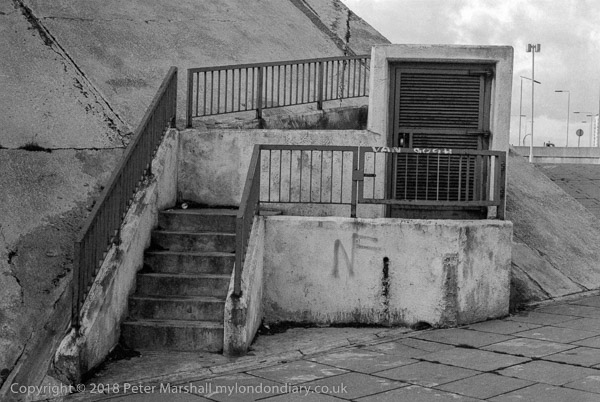
26r-41:roundabout,
http://londonphotographs.co.uk/london/1980/26r-41.htm
Another picture of the inside of the roundabout which was completed around 1972 and has appeared on record covers as well as being used as a film location – famously where Alex and his droogs beat up a singing drunk in Kubrick’s adaption of A Clockwork Orange. I have no idea why someone has painted Van Gogh on the railings -the Serbian rock group of that name was only founded six years later, but perhaps there may have been an earlier more local manifestation. And the National Front have been here too. There is a sinister look to this structure and doorway, and though I have no idea what is inside this concrete structure, it could well be a torture chamber.
The roundabout now has a rather odd metal structure on it, the ‘Atom’ monument, with two circular metal rings holding up a box with advertising screens for JCDecaux. If – as the firm who erected it claim – the adverts on it attract a great deal of driver attention, then they clearly decrease road safety at this critical junction. I can find no evidence for a local rumour that famed Brazilian architect Oscar Niemeyer had any part in its design. Wandsworth Council includes the structure on its list of works of art in the borough.
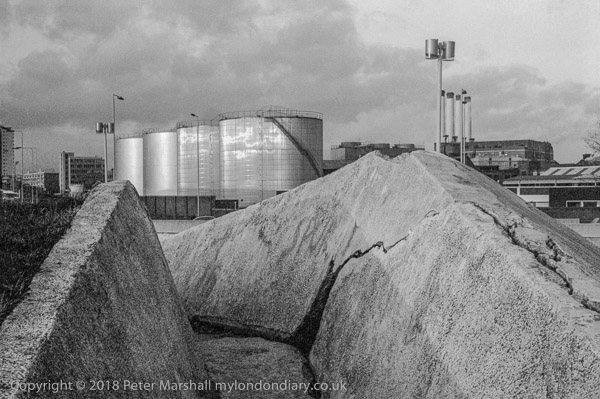
26r-42: roundabout, storage tanks
http://londonphotographs.co.uk/london/1980/26r-42.htm
This view from a higher level path inside Wandsworth roundabout shows some of its surroundings more clearly, including the storage tanks which I think were for Charrington’s Fuel Oils next to the river on the south bank immediately downstream of the bridge; incorporated in 1895, the company was dissolved in 1995. Charrington’s began in 1731 and was acquired in 1997 as a part of CPL Distribution Ltd, a company bought out by management from the British Coal Corporation in 1995. Charrington’s were one of the largest UK fuel oil distributors and also had a wharf downstream on Blackwall Way in E14, developed by Ballymore in 2002.
Also visible, on the other side of the river is Fulham Power Station, with its row of four chimneys.
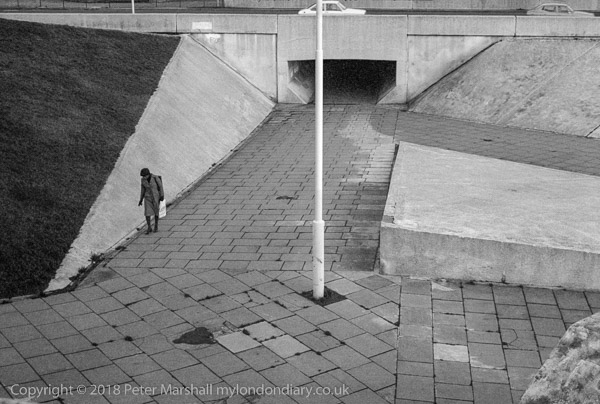
26r-43: roundabout, subway
http://londonphotographs.co.uk/london/1980/26r-43.htm
The final picture from the roundabout in 1980 shows a single figure walking in a concrete waste, walking away from one of the four underpasses which led to the central area. It emphasizes the modernist geometry of the construction and the sense of alienation the environment creates, something which has rather softened over the years as more vegetation has grown since it was built in 1969.
More recently it has been considerably tidied up with re-turfing and minor alterations which might prevent the flooding of the underpasses and with the intention of better maintenance, including a contract for the grass to be cut six times a year, though it remains to be seen how long this will last.
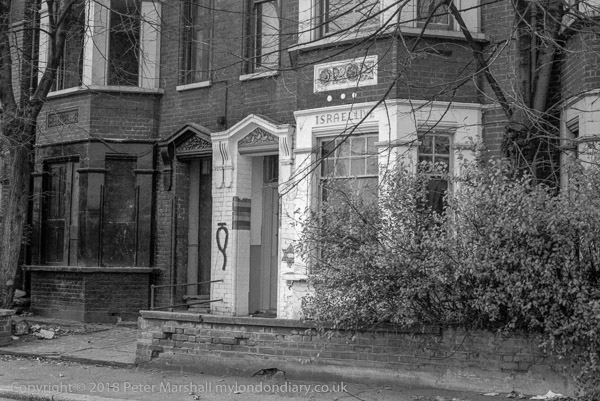
26s-31: house, rastafarian
http://londonphotographs.co.uk/london/1980/26s-31.htm
Houses in St Agnes Place were occupied by squatters from 1969 and survived Lambeth Council’s eviction attempt in 1977, which made the national news and eventually led to the fall of the then Conservative council.
Many of the occupants were Rastafari, as in this house, with its painted symbols and the message ‘ISRAEL: LIVE’ above the window. Many of the squatted properties were kept in good order, and the residents paid utility bills etc and for some years were a part of a housing co-op.
Some other properties were derelict and in a poor state, and the house on the left is boarded up.

St Agnes Place, Kennington. 1980
26s-32: house, rastafarian, fire damage, derelict,
Although No 22 looks in good condition and occupied, the house at right has been gutted by fire.
We walked through here fairly often when visiting friends who lived in Key House, just across the main road from here on the other side of the park, but I didn’t often stop to take photographs. We came to Kennington Park next to St Agnes Place for our children to play and sometimes took a little walk around.
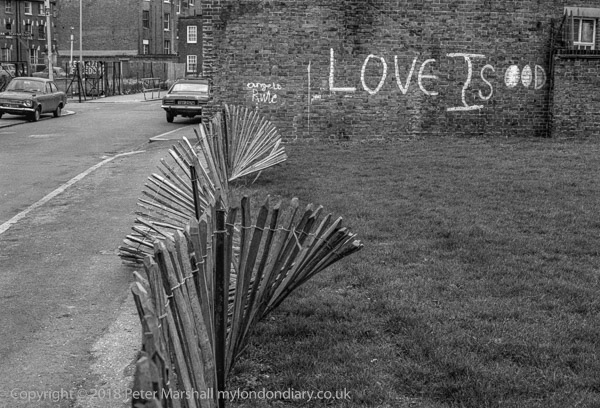
26s-42: house, graffiti, fence,
http://londonphotographs.co.uk/london/1980/26s42.htm
Graffiti on the end of a house I think once read ‘LOVE IS GOD’ but the G has been painted over to convert it to an O. But I don’t think OOD makes any sense. To its left is ‘angelo Rule’.
There are more graffiti on a wall across the road, including ‘LEGALISE FREEDOM?’ and a rather faded ‘DON’T PANIC’.
The fence has clearly seen better days.
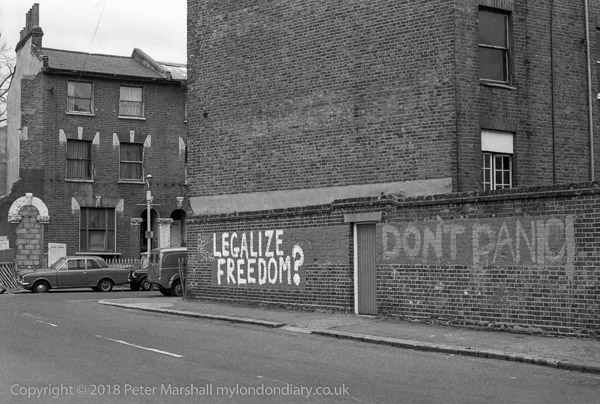
26s-43: house, graffiti
http://londonphotographs.co.uk/london/1980/26s-43.htm
St Agnes Place in 1980 began here, and the previous image was was taken in what was then Bolton Crescent looking towards St Agnes Place, but is now St Agnes Place. I had walked closer to photograph the wall with its graffiti ‘LEGALISE FREEDOM?’ and ‘DON’T PANIC!’.
There had previously been just one more house at the left of the picture which has been demolished, along with another building at an angle on the turn of the street. The doors leaning against the wall on both sides of the blocked up door probably came from this. Next to ‘Legalise Freedom?’ and rather smaller is the message ‘Ban The SPG’. The Special Patrol Group, a Met Police unit for dealing with public disorder and who the previous year had murdered Blair Peach at an Anti-Nazi League protest in Southall. They were found to have been using a number of unauthorised weapons, including a sledge-hammer and a crowbar. They were replaced in 1987 by the Territorial Support Group (TSG), though many think little was changed except the name.
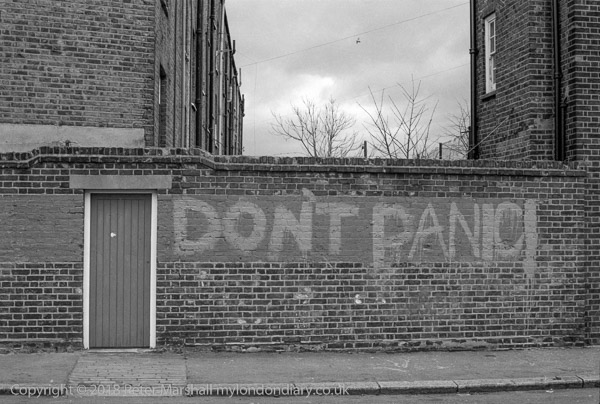
26s-44: house, graffiti
http://londonphotographs.co.uk/london/1980/26s-44.htm
Going a little closer still I photographed ‘DON’T PANIC!’ on its own, head on.
I think that some earlier graffiti had been painted out on this wall, and that this and the ‘LEGALISE FREEDOM?’ out of picture at the left had been painted on top of this, with the painter having a little problem squeezing the IC in at the end of the word before adding the oversize exclamation mark with some relief.
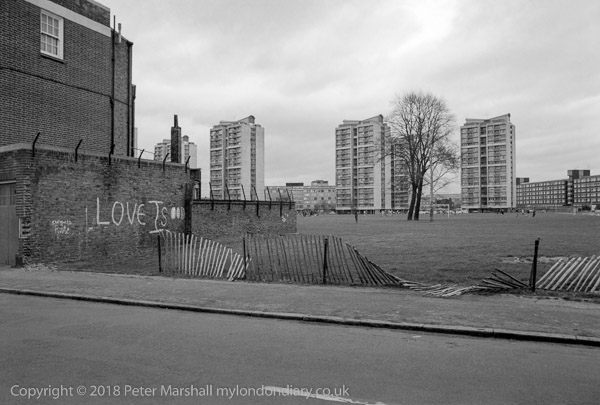
26s-54: house, graffiti, park, flats
http://londonphotographs.co.uk/london/1980/26s-54.htm
The flats seen across the playing field are on the Brandon Estate in Hillingdon Rd and Meadcroft Rd, and include Prescott House, Cruden House, Bateman House, Walters House and Cornish House, built in 1958 by the London County Council. Many of the early residents were delighted; they had been moved in more or less a whole street at a time and kept their community spirit in flats built to much higher standards than the slums that were demolished, a community-based approach that has been abandoned to allow private developers to profit from estate demolition.
20 Years later the estate had gone down-hill, partly because of bad management and the removal of caretakers, but mainly because council housing became a service for problem families rather than a more general approach to providing rented properties at a fair price.
This part of the street was still Bolton Crescent when I took the picture, but St Agnes Place now extends further south.
This is the final post in the series of selected images that I made in London in 1980. You can now see all the pictures (and a few more) at a larger size and with the descriptions here on Flickr.
All photographs on this and my other sites, unless otherwise stated, are taken by and copyright of Peter Marshall, and are available for reproduction or can be bought as prints.
There are no adverts on this site and it receives no sponsorship, and I like to keep it that way. But it does take a considerable amount of my time and thought, and if you enjoy reading it, please share on social media.
And small donations via Paypal – perhaps the cost of a beer – would be appreciated.